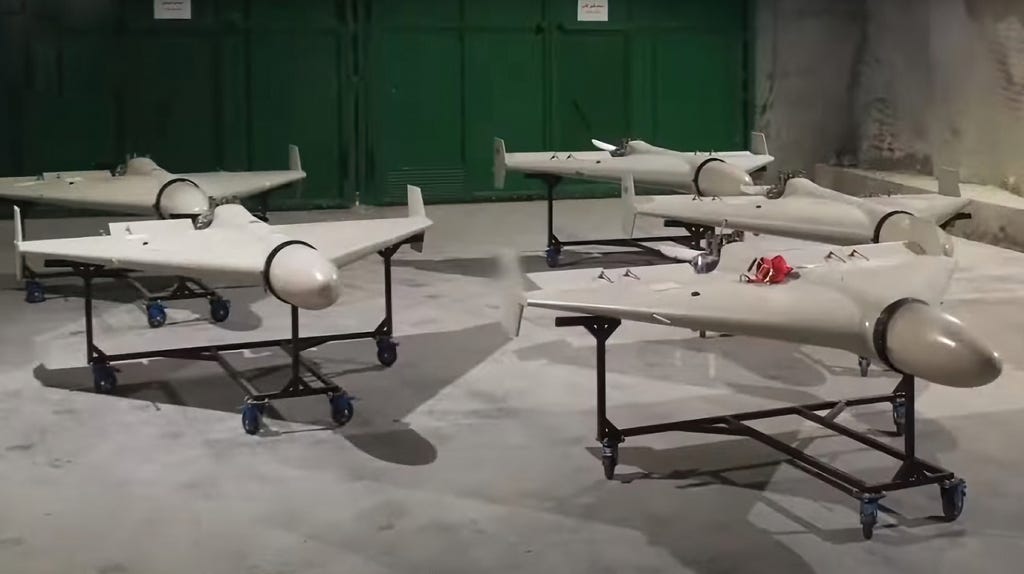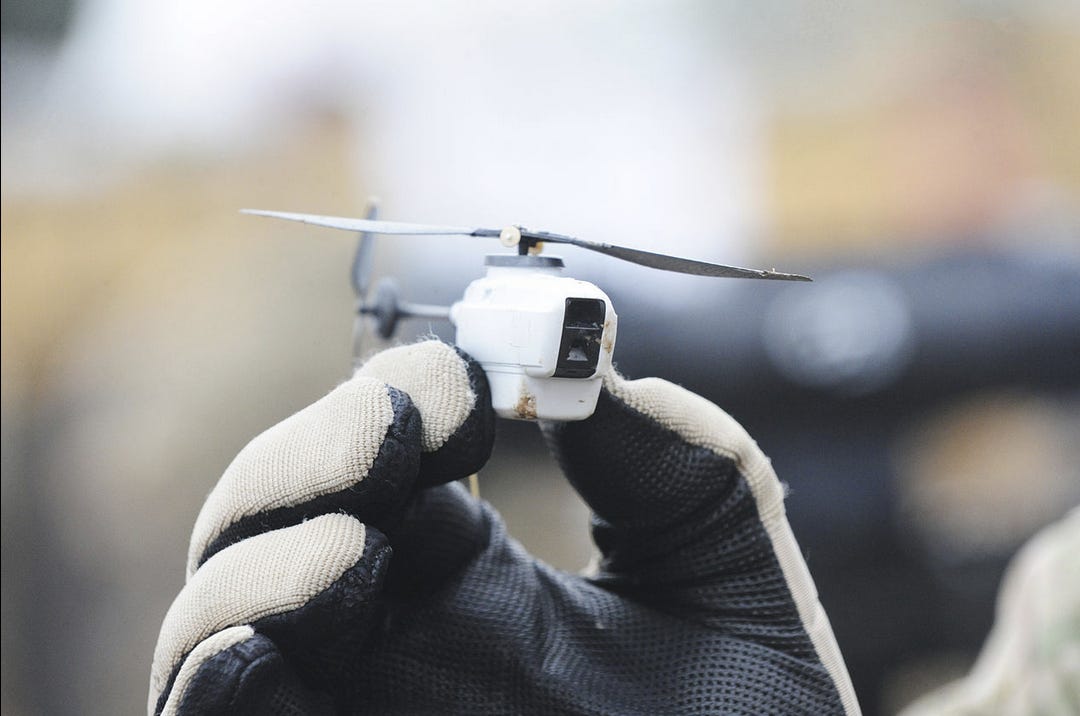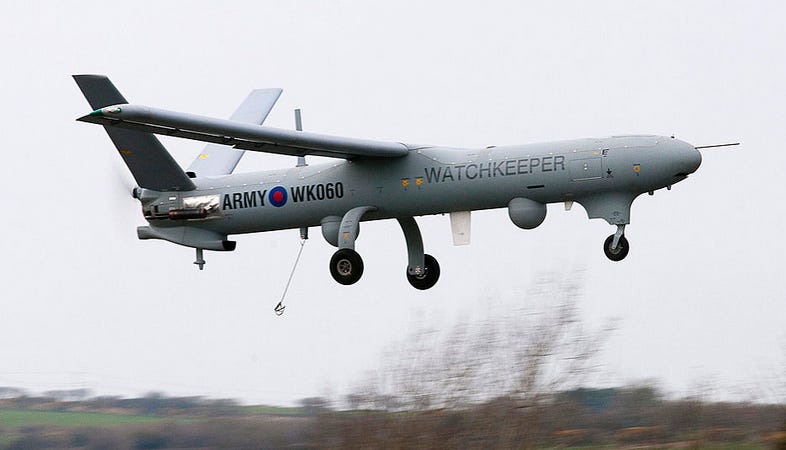Scottish Defence Policy #4: Drones
Lessons learned from Russian use of the Iranian Shahed-136 drone in Ukraine
This is part 4 of a series on the defence policy of a future independent Scotland. Having said that, most of the things I talk about and points I make apply equally well to many other countries. In this part, we discuss drones.
The Iranian Shahed-136 drone
In the last few weeks, Russia has bought hundreds of drones from Iran for use against Ukraine. Among these is the Shahed 136, whose name in Persian means witness, or more idiomatically martyr, which is appropriate as it is a suicide drone. In Russian service it's known as the Geran-2, Geran meaning geranium. Russia names lots of artillery systems after flowers, so maybe they consider it to be long-range artillery.
The Shahed-136 is powered by a 50 hp 550 cc petrol engine. Its speed is about 190 km/hr and range is around 2000 km. It can deliver a payload of 30-50 kg. It is guided by satellite navigation (GPS, Glonass, etc), and thus is only useful against static targets whose locations are known; it is probably however quite accurate since satnav is generally accurate to within a few meters.
The implication of all this is that it can destroy a static target at a known location, for example a building, up to 2000 km away. It is also effective against parked unarmoured and lightly armoured vehicles. Because of its low speed it is vulnerable to anti-aircraft missiles and artillery; however, if there are lots of targets, they can't all be defended.
The most attractive feature of the Shahed-136 is its cost which is estimated at between $10,000 and $50,000. This is a lower cost than an anti-aircraft missile, making it hard to counter, because shooting down a $20k target with a $200k missile isn't cost effective, and in a war between roughly equal adversaries, an attacker can afford more drones than a defender can AA missiles.
Creating a whole family of drones
If a country, such as a newly-independent Scotland, wanted to create a family of drones for various purposes, how might they do it? A good start might be to to take the Shahed 136 as a starting point and manufacture modified versions. I propose that it would be sensible policy for a country to manufacture a family of medium-sized drones, with as much commonality of components and software between them as possible, for a varaiety of purposes:
A surveillance platform with optical, infra-red and possibly radar sensors. This would be used, among other tasks, to direct artillery fire. This role is known as ISTAR (for intelligence, surveillance, target acquisition, and reconnaissance), because militaries love acronyms.
A loitering munition with optical sensors that uses computer vision to recognise a library of targets, such as vehicles, and target them when recognised. Or it could fly along the course of a road/railway, until it sees a moving target. (Possibly there would be a human in the loop; or possibly not. At longer ranges, or when the enemy is jamming signals, it would be difficult to get pictures of the target back to a control center.)
A swarm of surveillance platforms and munition drones which talk to each other to collectively attack a large target, such as an aircraft carrier. Most or all of these drones would be fitted with tactical datalinks so they can communicate with each other and report back any data they have.
Carrying a laser designator to designate targets for larger missiles.
A close air support variant, armed with a machine gun or small bombs to attack enemy formations. The drone could either be remotely controlled by a human operator, or autonomous, or a mixture of the two. here the drone is being used in the same role that CAS aircraft were used in WW2. An FN MAG machine gun (12 kg) with 200 rounds of ammo (5 kg) weighs 17 kg, which is significantly less than the Shahed-136's 30-50 kg explosive payload.
A fighter drone, armed with a machine gun to hunt and destroy enemy drones.
A navigational aid. Imagine a world where GPS is down, perhaps because it has been targetted by enemy action. Then there could be ground base stations transmitting navigational signals, a number of drones could fly and use those signals to infer their own locations, and use that information to send their own signals to help other aircraft/vehicles navigate. Emitting the signals from an airborne platform is better than from the ground, as they will have greater range.
There are also non-military uses such as a search and rescue drone that uses infra-red or radar to detect humans. Or a police drone for monitoring crowds/situations, an agricultural drone for monitoring crops, or a map-making drone, for adding bird's-eye view images to Open Street Map.
It would make sense to develop drones that're more autonomous, using AI to make decisions for themselves. In a manually controlled drone, the drone sends moving pictures back to a human operator who in turn gives it instructions -- where to move to, whether to attack a target. The problem with is is it requires radio communications between the operator and the drone. This limits the drone's range and also the communications can be jammed. Therefore it is advantageous to have a drone that is more autonomous, for example if communications with the operator are down. In this instance the drone can decide what to do and whether to attack a target. Advances in AI particularly in image recognition, make autonomous drones more practical than they would have been 10 years ago.
The more roles that can be found for a drone platform, the larger the production run, and the lower the unit cost. Similarly if lots of countries manufacture a common platform between them, with a modular architecture so that any of them can produce new variants, then again, more will be produced and the unit cost lower. I envisage such a drone as being split between two parts: one airframe module, which works with multiple mission modules (in much the same way that the Boxer armoured fighting vehicle has a drive module and various mission modules).
Drones currently used by the UK
We've seen above how a family of inexpensive drones with re-usable components could be designed. Now let's compare them to the drones the UK uses. I've chosen the UK because it somewhat representative of NATO countries and also because I am using a hypothetical independent Scotland to explore where UK defence policy gets it wrong.
So, what drones does the British army use?
Black Hornet Nano
This is a nifty nano-drone that is 16 cm long and weighs 18 g, so is in a different class to the family of drones I'm considering in this post. It does look rather cool though. The UK has 324 of them at £60,000 each.
Honeywell RQ-16 Tarantula Hawk
Like the Black Hornet Nano, this is a short-range tactical drone, so again is out of context for this article.
Lockheed Martin Desert Hawk III
This is the sort of drone I envisage (although slightly smaller than the Shahed-136) The Uk paid Lockheed martin $4.8M for an unknown quantity, and in 2013, they had 222 Desert Hawk IIIs in service. Assuming the order was for 222 drones that would be $21k each, so that's within the price range I envisage.
In terms of flight characteristics, the DHIII has a maximum speed of 92 km/h, an endurance of 90 minutes and a range of 15 km (governed by the limits of radio communications with its controller).
The DHIII can be equipped with a wide range of sensors: visual light and infra-red cameras, synthetic aperture radar, and sensors to detect enemy radio emissions.
Overall, DHIII is an impressive package: not overly complicated and with a wide range of sensors. A faster version with greater range and altitude would be a versatile ISTAR platform.
Thales Watchkeeper WK450
This is very much the sort of drone I envisage as part of the family-of-drones.
It's somewhat larger but slower than the Shahed-136 (takeoff weight 485 kg; endurance of 14 hours at 143 km/hr; payload 150 kg). Watchkeeper is a joint venture between French company Thales and Israeli company Elbit and is based on the Elbit Hermes 450. Watchkeeper has visible-light and infrared sensors, and also a synthetic aperture radar allowing it to spot moving objects on the ground, such as convoys of vehicles. This is an improvement over Hermes, which doesn't have radar.
Watchkeeper is however not cheap: The UK has ordered 54 Watchkeepers and the original programme cost in 2005 was £700M (so £13 million each). But now the expected total cost is £1.2 bn, increasing the unit cost to a hefty £22M (c. $25M). Watchkeeper has impressive sensors but it is not obvious that it is good value for money, since a proficient adversary like Russia or China would no doubt attempt to shoot them down, and given that the aircraft is slow and emitting lots of radio signals it may well be an easy target.
Incidentally the Royal Air Force already operate a UAV that would be as good platform for Watchkeeper's sensor -- the Storm Shadow cruise missile, which has a 1000 km/hr top speed and whose 450 kg warhead could be replaced with sensors, fuel, etc. Storm Shadow cost £790,000 each at the time it was built, which would be about £2 million now, so it would be cheaper than Watchkeeper too.
If I was paying $25 million for a drone, I'd want it to be a lot faster, which would give it more survivability near enemy-controlled territory. Drones should either be cheap (in which case it doesn't matter if they are lost), or expensive and survivable (so they won't get lost). drones that are expensive but easily shot down are not the way to go.
How might drones be countered?
Drones are going to be increasingly used in future wars. They've been effective in the current Russia-Ukraine war and also in other recent wars such as the ongoing Ethiopian civil war and the 2020 Nagorno-Karabakh war.
So, how to counter them? Countering expensive drones is straightforward: you just shoot them down like you would piloted aircraft. Countering swarms of cheap drones is another matter. Here are some suggestions:
Missiles. As I pointed out above, anti-aircraft missiles are not cost effective against cheap drones, although they are against expensive drones.
Guns. Fast-firing guns with a calibre of c. 20 to 40 mm will be effective against slow moving and low flying drones. For example the American C-RAM has a 20 mm Gatling gun controlled by radar. Since bullets and explosive shells are cheap, this is a cost-effective solution. However, the further away the drone is and the faster it is flying, the harder it is to hit with an unguided projectile, especially if the drone is manoeuvring.
Lasers. Light travels at the speed of light, far faster than any aircraft, which makes fire control systems much simpler: you just point straight at the target, you don't have to calculate where the target will be by the time the projectile gets to it. Laser-based weapons are however less effective if there is fog, mist or smoke. lasers are like guns in that, while the platform may be expensive, the cost-per-engagement isn't.
Fighter drones. If drones are effective, set a drone to catch a drone. Armed with a machine gun, a fighter drone could be directed to the general vicinity of the target, and would then use its own sensors to get close enough to fire at it.
Summary
Drones will see increasing use by militaries worldwide and will be used in future wars. While some drones will be big and expensive (like a modern fighter aircraft but without a pilot), other drones will be smaller and cheaper. Small cheap drones will be particularly attractive to countries without vast military budgets, i.e. most countries. A typical mid-sized middle income country will be able to build its own drones (like Turkey and Iran do).
Because cheap drones can be deployed in large numbers, it will be hard to counter them and thus they will be effective weapon systems that many nations will want to operate. At the same time, their effectiveness will lead to increasing development of weapons that can counter them. I expect ground-based laser weapons, and anti-drone fighter drones, to be two of the most effective counters.
Low-cost drones do not require enormous technical sophistication to manufacture: middle-income countries such as Turkey and Iran have large drone industries. Therefore we can expect many mid-tier countries to establish their own drone industries. It would make a lot of sense for an independent Scotland to develop a drone industry, either on its own or in collaboration with other NATO or EU countries. Scotland should also invest in AI for drones, both to make drones more autonomous and as part of a national AI industrial strategy.
(On the subject of AI, the cover picture for this article was computer-generated by StockAI.)
Further reading
Wikipedia: HESA Shahed 136
Military factory: HESA Shahed-136
Binkov video on Iranian drone use by Russia
/end








>The UK has 324 of them at £60,000 each.
Holy shit. Next time leave the fucken diamonds out and then it will be a tenner. This is ridiculous.